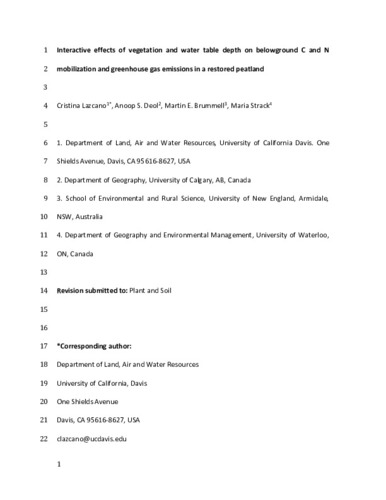| dc.contributor.author | Lazcano, Cristina | |
| dc.contributor.author | Deol, Anoop | |
| dc.contributor.author | Brummell, Martin | |
| dc.contributor.author | Strack, Maria | |
| dc.date.accessioned | 2023-05-03 12:58:41 (GMT) | |
| dc.date.available | 2023-05-03 12:58:41 (GMT) | |
| dc.date.issued | 2020-01-27 | |
| dc.identifier.uri | https://doi.org/10.1007/s11104-020-04434-2 | |
| dc.identifier.uri | http://hdl.handle.net/10012/19400 | |
| dc.description | This is a post-peer-review, pre-copyedit version of an article published in Plant and Soil. The final authenticated version is available online at: https://doi.org/10.1007/s11104-020-04434-2 | en |
| dc.description.abstract | Aims
This study assesses the relative effects of hydrology and colonization by vascular plants on belowground C and N mobilization, and emission of CO2 and CH4 in an extracted bog under restoration in Alberta (Canada).
Methods
A wet (high water table) and dry (low water table) area were identified at the site and plots with cottongrass (Eriophorum vaginatum) or bare peat were established in each area. Plant growth, peat and porewater dissolved C (DOC) and N (TDN), microbial biomass and the emissions of CO2 and CH4 were monitored at the plots throughout the growing season.
Results
The largest concentrations of DOC were measured in dry and bare sites. Lower E2:E3 ratios suggested a higher aromaticity of the DOC at these sites that were net sources of CO2 and CH4. The concentration of TDN was greater in plots with cottongrass and high water table, supporting a more abundant microbial biomass. Cottongrass dominated plots also had larger gas emissions as compared to bare plots even though they were net C sinks due to their high photosynthetic rates.
Conclusion
Maintaining a high water table is key to reducing peatland C losses. While vascular plant presence seems to prime the release of N and greenhouse gases, the inputs of C exceeded the losses and recovered the C sink function of the peatland ecosystem in the short term. Carbon inputs are maximized under high water table and plant presence. | en |
| dc.description.sponsorship | Funding was provided by a Collaborative Research and Development Grant from the Natural Sciences and Engineering Research Council of Canada (NSERC), supported by the Canadian Sphagnum Peat Moss Association and its members. Site access and logistical support were provided by Sungro Horticulture Inc. | en |
| dc.language.iso | en | en |
| dc.publisher | Springer | en |
| dc.relation.ispartofseries | Plant and Soil;448 | |
| dc.subject | Eriophorum vaginatum | en |
| dc.subject | plant-soil interactions | en |
| dc.subject | ecosystem restoration | en |
| dc.subject | C cycling | en |
| dc.subject | N cycling | en |
| dc.subject | ecohydrology | en |
| dc.title | Interactive effects of vegetation and water table depth on belowground C and N mobilization and greenhouse gas emissions in a restored peatland | en |
| dc.type | Article | en |
| dcterms.bibliographicCitation | Lazcano, C., Deol, A.S., Brummell, M.E., Strack, M. 2020. Interactive effects of vegetation and water table depth on belowground C and N mobilization and greenhouse gas emissions in a restored peatland. Plant and Soil, 448, 299-313, https://doi.org/10.1007/s11104-020-04434-2 | en |
| uws.contributor.affiliation1 | Faculty of Environment | en |
| uws.contributor.affiliation2 | Geography and Environmental Management | en |
| uws.typeOfResource | Text | en |
| uws.peerReviewStatus | Reviewed | en |
| uws.scholarLevel | Faculty | en |

